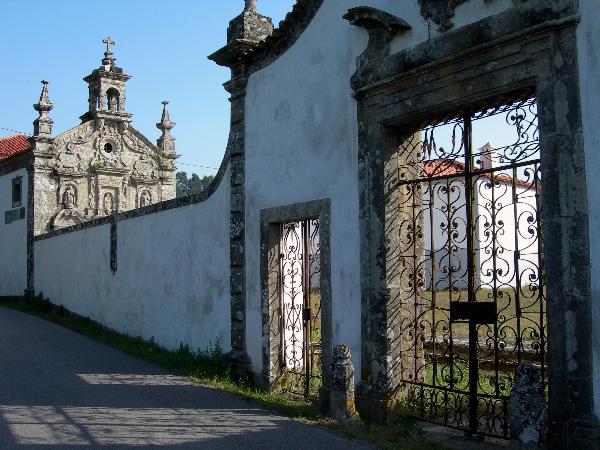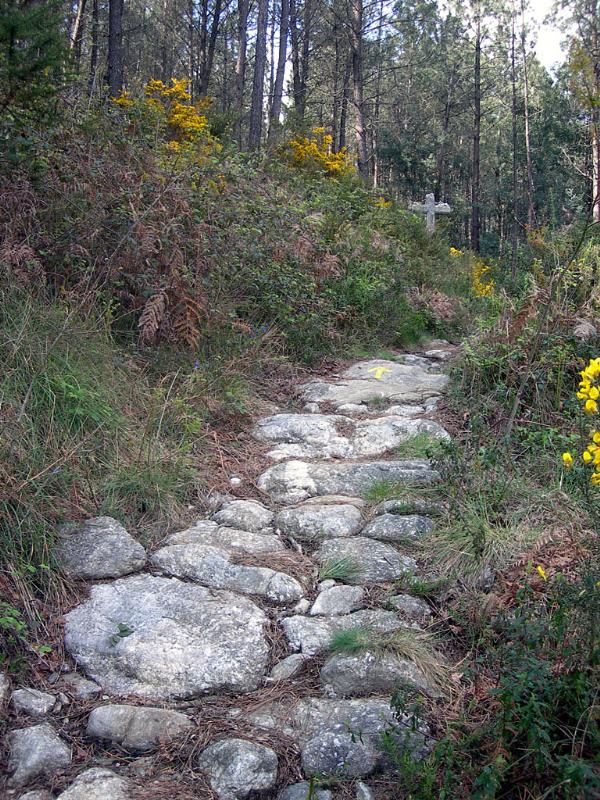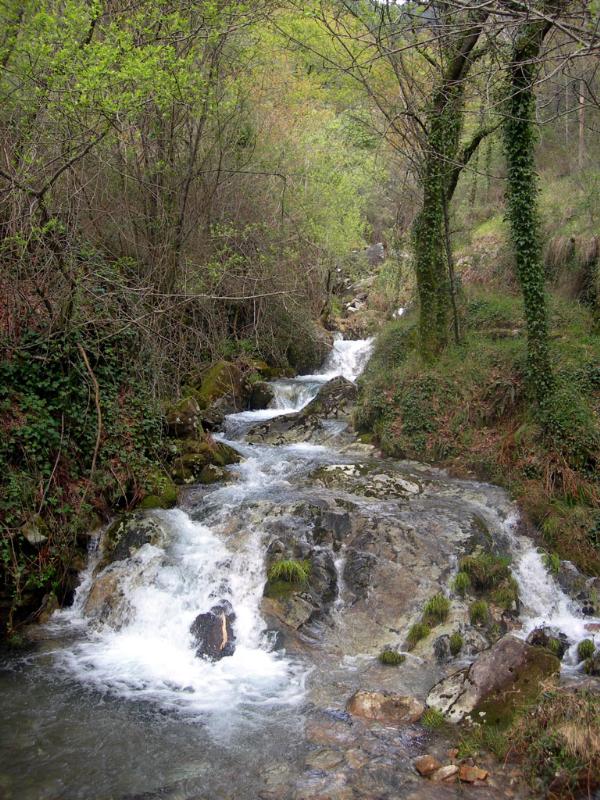* Português *
Acordou sobressaltado com o barulho da aproximação dos perseguidores, uma populaça exaltada que não dava tréguas aos poucos sobreviventes do massacre da noite anterior. Ocorreu-lhe de imediato que não conseguiria passar desapercebido envergando ainda o orgulhoso uniforme do exército de Napoleão.
Ainda ontem tudo parecia correr bem. As tropas imperiais recuavam de regresso a França, desgastadas pelos ataques dos Ingleses de Wellesley e pelas emboscadas dos Portugueses de Silveira. Pelo menos voltavam para casa e, pelo caminho, iam acumulando pilhagens e matanças. E aquela casa de Romarigães – os camponeses chamaram-lhe a “Casa Grande” – parecia ser de gente abastada! Era só vasculhar e encontrariam ouro escondido. Quando entraram na capela anexa à casa, um camarada veterano disse: “Este raio de fidalgos são católicos até aos dentes. Vejam bem. Aqui na capela, em sítio em que menos se pensa, é que eles são capazes de esconder o pognon.” (*). Não demorou muito até encontrarem, debaixo da pedra do altar, o tesouro de Luís António de Menezes da Cunha e Azevedo.
Carregando o saque, seguiram para Norte, pelo Caminho de Santiago. Pouco faltaria para atingirem a segurança das terras de Espanha mas a noite surpreendeu-os numa encosta íngreme onde os populares sedentos de vingança aguardavam emboscados. Foi uma chacina. Ele conseguiu escapar, nem se lembra bem como, carregando a arca com os dobrões da Casa Grande. Correu até cair de exaustão e adormeceu.
E agora aproximavam-se uma vez mais, ainda sedentos de sangue francês. Fugiu ao longo de um ribeiro, mas a arca pesava-lhe nos braços. Escondeu-a rapidamente, tencionando voltar quando tudo estivesse calmo. Continuou ao longo do ribeiro, mas depressa se apercebeu que estava encurralado entre duas intransponíveis paredes de rocha. “Sapristi! Misérables paysans!” Os camponeses já estavam demasiado perto para poder voltar para trás. Foi morto ali mesmo, ungindo de vermelho as límpidas águas do ribeiro de S. João.
Com ele morreu o segredo do ouro roubado de Romarigães.
Inicie a busca na Casa Grande de Romarigães (N 41 52.012 W 008 37.524), uma edificação senhorial do século XVII que inspirou Aquilino Ribeiro à escrita da crónica romanceada com o mesmo nome, que trata a intensa e trágica história das gerações dos Meneses Montenegro que lá viveram. A casa acabou por pertencer, já no século XX, à família do escritor, após venda em hasta pública. A casa ostenta ainda, no seu alçado Norte, as armas dos Antas da Cunha. Tome nota do número de lisonjas (ou losangos) que formam a cruz que figura nesse brasão.

Casa Grande de Romarigães
Siga depois para a capela de Santana - ou Santa Ana (N 41 50.954 W 008 36.121). Conte o número de “comedores de carne” (do grego “sarkóphagos”) que se encontram junto à capela desde os tempos medievais.
Por fim, inicie em N 41 50.821 W 008 36.130 a sua caminhada de redenção, percorrendo a pé parte de um dos troços mais difíceis do Caminho de Santiago Português. Esta parte do trilho, que começa na borda da estrada asfaltada, está indicada por setas amarelas, que deverá seguir cuidadosamente até encontrar o local do trágico massacre dos soldados napoleónicos, assinalado pela chamada “Cruz dos Franceses.” Meça a largura do braço horizontal da cruz em “palmos de côvado” (medida de comprimento usada na época, equivalente a 22,6 cm).

Cruz dos Franceses
Já pode agora calcular as coordenadas finais da cache, segundo a fórmula:
N 41 51.(A+B-C)AA W 008 35.(2xC)(A+B)A
A = número de lisonjas (losangos) na cruz do brasão dos Antas da Cunha na Casa Grande
B = número de sarcófagos junto da capela de Santana
C = largura do braço da Cruz dos Franceses em palmos de côvado (arredondada às unidades)
O sinal de GPS na área se encontra a cache final é fraco! Use a foto-hint disponível para facilitar a localização da cache final!
Note que o percurso desde a Cruz dos Franceses até próximo do ouro escondido pode ser feito integralmente seguindo por trilhos e estradões.

Ribeiro
(*) In “A Casa Grande de Romarigães” de Aquilino Ribeiro.
* English *
He woke up suddenly, with the sound of the approaching pursuers. The populace that searched the few survivors of last night’s massacre was not going to quit easily. And he, still wearing the uniform of Napoleon’s army, would not pass unnoticed.
Just yesterday everything seemed to be going reasonably well. The imperial troops retreated, worn out by the attacks of Wellesley’s British troops and the ambushes of the Portuguese, commanded by Silveira. At least they were going home and, by the way, accumulated lootings and killings. And that house in Romarigães – the peasants called it “the Large House” – seemed to belong to wealthy people. If they looked, they would certainly find hidden gold.
When they entered the chappel next to the house, a veteran said: “These damn nobles are rich up to their teeth. Look properly. Here in the chapel, where you less expect, that’s where they may have hidden the pognon” (*). And, after saying this, they found, under the altar stone, the treasure of Luís António de Menezes da Cunha e Azevedo.
Carrying the loot, they followed towards North, along the Path to Santiago. Soon they would be in Spanish ground. It was night already when the peasants ambushed them, in a steep slope. It was a bloodbath. He managed to escape, he can’t quite remember how, carrying the chest with the gold coins from the Large House. He ran until falling from exhaustion and fell asleep.
And now they were approaching, still thirsty for French blood. He ran along a brook. But the chest was too heavy. He hid it quickly, intending to return after everything were quieter. He continued along the brook. But soon he realized that he was trapped between two stone walls. “Sapristi! Misérables paysans!” The peasants were already to close for turning back.
He was killed right here, turning red the clear waters of St. John’s brook.
With him died the secret of the stolen gold of Romarigães.
Start the search in the Manor House of Romarigães (Casa Grande de Romarigães) (N 41 52.012 W 008 37.524), a XVII century building that inspired Aquilino Ribeiro to write the novel with the same name, describing the intense and tragic story of the several generations of the Meneses Montenegro that lived in it. The house ended up belonging to the writer’s family, already in the XX century, after being sold for paying debts. The house still displays, in its Northern face, the coat of arms of the Antas da Cunha family. Take note of the number of lozenges that make the cross displayed in that shield.
Follow then to the chapel of Santana – or St. Ana (N 41 50.954 W 008 36.121). Count the number of “meat eaters” (from the greek “sarkóphagos”) which are next to the chapel since medieval times.
Finally, start at N 41 50.821 W 008 36.130 your path to redemption, walking along one of the hardest stretches of the Portuguese Path to Santiago (Caminho de Santiago). This part of the trail, which starts at the border of the asphalt road, is marked with yellow arrows, which you should follow carefully until finding the place of the tragic massacre of Napoleon’s soldiers. This location is signalled by the “Cross of the French” (Cruz dos Franceses). Measure the width of its horizontal arm, in “côvado” palms (a unit of length used at the time, equivalent to 22,6 cm)
Now you can calculate the cache’s final coordinates, using the formula:
N 41 51.(A+B-C)AA W 008 35.(2xC)(A+B)A
A = number of lozenges in the cross of Antas da Cunha’s coat of arms
B = number of sarcophagus next to Santana’s chapel
C = width of the Cross of the French’s horizontal arm, measured in “côvado” palms (rounded to unity).
The GPS signal is weak in the area of the final cache! You should use the photo-hint in order to locate the final cache faster!
Note that the way from the Cross of the French until close to the hidden gold can be done integrally by following along trails and country roads.

Caminho de Santiago